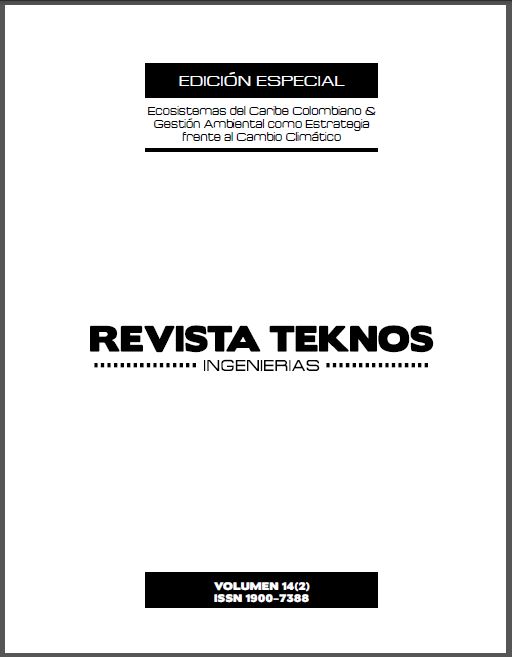Foliar Dehydration Rate Estimation and its Importance for the Terrestrial Ecosystems in the Caribbean Region of Colombia
DOI:
https://doi.org/10.25044/25392190.466Keywords:
climate change, foliar dehydration, evapotranspiration, temperature, water balance.Abstract
The knowledge of the plants biology, especially of the tolerance these may have against current environmental changes with respect to climate change, is of a great importance to identify those species able to resist water stress produced due to both increased evapotranspiration rate and dehydration. Therefore, by means of this study, the rates of leaf dehydration of eleven major plant species were compared. These species are mainly present within two strategic ecosystems of Cartagena, Colombia (Juan Angola creek and La Popa hill), which belong mostly (36%) to the Fabaceae family, followed by Malvaceae, Rubiaceae, Ancaradiaceae, Sapindaceae, Combrataceae, Apocynaceae, and Rizophoraceae with 9% each. The results place the Laguncularia racemosa species as the one with the highest rate of leaf dehydration (23.35 ± mg H2O/h); while Guazima ulmifolia was the species with the lowest rate of dehydration (3.51 ± 1.63 mg H2O/h). The results found in the study are discussed with respect to the importance of the information obtained for ecological and environmental management of local ecosystems of the city in the context of a future scenario of climate change.Downloads
References
Afanador, F. O. (2008). Ortofotografía digital y datos LIDAR para el control y administración del litoral en la Isla de Tierra Bomba, Caribe Colombiano. Boletín Científico CIOH No. 26.
Alcaldía Mayor de Cartagena de Indias, Decreto 0977. (2001). Plan de Ordenamiento Territorial (POT), del Distrito Turístico y Cultural de Cartagena de Indias. Cartagena, Colombia..
Bartoskova H., J. Komenda & J. Naus. (1999). Functional changes of photosystem II in the moss Rhizomnium punctatum (Hedw.) Induced by diffrent rates of dark desication. J. Plant Physiol., 54, 597-604.
Basnayake, J. C. (1996). Influence of rate of development of water deficit on the expression of maximum osmotic adjustment and desiccation tolerance in three grain sorghum lines. Filed Crops Research, 49, 65-76.
Begcy K., E. Mariano, L. Mantiello, A. Nunes, P. Mazzafera, I. Maia & M. Menosi. (2011). An Arabidopsis Mitochondrial Uncoupling Protein Confers Tolerance to Drought and Salt Stress in Transgenic Tobacco Plants. PLoS ONE., 6(8), 1-9. doi:10.1371/journal.pone.0023776
Camia, A. B. (1999). Meteorological fire danger indices and remote sensing. Remote Sensing of Large Wildfires, 39-59.
Chuvieco, E. S. (2001). Estimación del estado hídrico de la vegetación a partir de sensores de alta y baja resolución. Revista Internacional de ciencia y tecnología, 1, 1-16.
Cocero D., D. Riaño & E. Chuvieco. (2000). Estimación de la humedad de diferentes especies vegetales mediterráneas mediante distintos sensores de teledetección. Tecnologías Geográficas para el Desarrollo Sostenible. Departamento de Geografía. Universidad de Alcalá. 200-221.
Drennan, P. M. (2009). Marginal and laminar hydathodelike structures in the leaves of the desiccation-tolerant angiosperm Myrothamnus flabellifolius Welw. Flora – Morfology, Distribution, Functional Ecology of Plants, 204(3), 210-219.
Garcés F. & C. Forcellini. (2011). Peso de hojas como herramienta para estimar el área foliar en Soya. Ciencia y Tecnología, 4(1), 13-18.
González, H. (2001). Adaptación a la sequía de la planta arbustiva de matorral Espinoso Tamaulipecco. Ciencia UANL., 4, 454-461.
González-Bermúdez, A. (2013). Respuesta de la densidad estomática a características foliares e individuales en tres especies de árboles en Gamboa , Panamá. Pensamiento Actual, Vol. 13 (20), 43-49.
Jones R. (1995). Sucrose prevents foliage dessication in cut Leucadendron “Silvan Red” during cool storage. Postharvest Biology and Technology, 6(3), 293-301.
Hegbe J. & M. Hossein. (2010). Water relations, gas Exchange, and yield of processing tomato under reduced irrigation. Revista Mexicana de Ciencias Agrícolas, 1(3), 445-450. Ministerio de Ambiente y Desarrollo Sostenible (Minambiente). Recuperado el 02 de 05 de 2014, de http://www.minambiente.gov.co/documentos/DocumentosBiodiversidad/proyectos_norma/proyectos/241011_proy_dec_ley_2811_ordenacion_forestal_121111.pdf.
Oliver M., R. Jain., T. Balbuena, G. Agrawal., F. Gasulla & J. Thelen. (2011). Phitochemistry, 72, 1273-1284.
Pence V., S. Dunford & S. Redella. (2005). Differential effcts of abscisic acido on desecation tolerance and carbohydrates in three species of liveworts. Journal of Plant Physiology, 162, 1331-1337.
Rodríguez-Pérez, L. (2006). Implicaciones fisiológicas de la osmoregulación en plantas. Agronomía Colombiana, 24(19), 28-37.
Zapata, P. (2010). Efecto del guácimo (Guazuma ulmifolia), carao (Cassia grandis) y roble (Tabebuia rosea) sobre la productividad primaria neta aérea y composición florística de pasturas naturales en Muy Muy y Matiguás, Nicaragua. (Tesis de magíster). Recuperado de http://orton.catie.ac.cr/repdoc/A4665E/A4665E.PDF
Downloads
Published
How to Cite
Issue
Section








